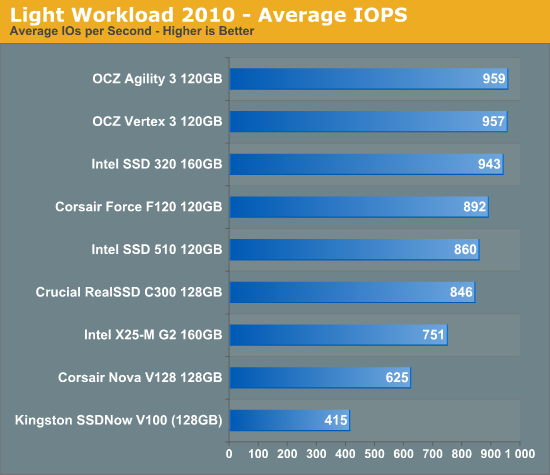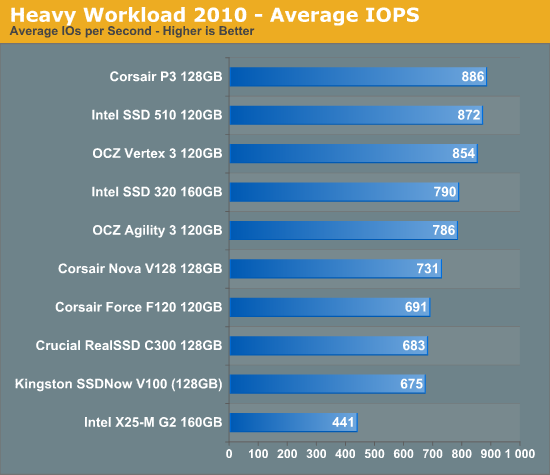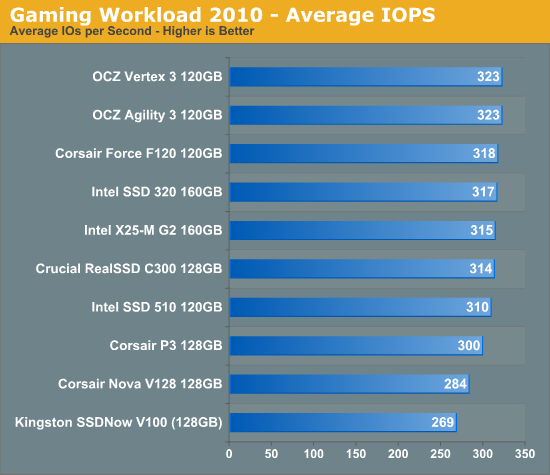The 2011 Mid-Range SSD Roundup: 120GB Agility 3, Intel 510 and More Compared
by Anand Lal Shimpi on June 7, 2011 12:52 PM ESTAnandTech Storage Bench 2010
To keep things consistent we've also included our older Storage Bench. Note that the old storage test system doesn't have a SATA 6Gbps controller, so we only have one result for the 6Gbps drives.
The first in our benchmark suite is a light/typical usage case. The Windows 7 system is loaded with Firefox, Office 2007 and Adobe Reader among other applications. With Firefox we browse web pages like Facebook, AnandTech, Digg and other sites. Outlook is also running and we use it to check emails, create and send a message with a PDF attachment. Adobe Reader is used to view some PDFs. Excel 2007 is used to create a spreadsheet, graphs and save the document. The same goes for Word 2007. We open and step through a presentation in PowerPoint 2007 received as an email attachment before saving it to the desktop. Finally we watch a bit of a Firefly episode in Windows Media Player 11.
There’s some level of multitasking going on here but it’s not unreasonable by any means. Generally the application tasks proceed linearly, with the exception of things like web browsing which may happen in between one of the other tasks.
The recording is played back on all of our drives here today. Remember that we’re isolating disk performance, all we’re doing is playing back every single disk access that happened in that ~5 minute period of usage. The light workload is composed of 37,501 reads and 20,268 writes. Over 30% of the IOs are 4KB, 11% are 16KB, 22% are 32KB and approximately 13% are 64KB in size. Less than 30% of the operations are absolutely sequential in nature. Average queue depth is 6.09 IOs.
The performance results are reported in average I/O Operations per Second (IOPS):

Our old light workload from 2010 highlights an important point about all of these SSDs. For light usage, in a completely IO bound workload, there's only a 13% difference in performance between the fastest 6Gbps drive and last year's C300. If there's only a 13% difference in this completely IO bound test, the real world difference will surely be nonexistent.
If there’s a light usage case there’s bound to be a heavy one. In this test we have Microsoft Security Essentials running in the background with real time virus scanning enabled. We also perform a quick scan in the middle of the test. Firefox, Outlook, Excel, Word and Powerpoint are all used the same as they were in the light test. We add Photoshop CS4 to the mix, opening a bunch of 12MP images, editing them, then saving them as highly compressed JPGs for web publishing. Windows 7’s picture viewer is used to view a bunch of pictures on the hard drive. We use 7-zip to create and extract .7z archives. Downloading is also prominently featured in our heavy test; we download large files from the Internet during portions of the benchmark, as well as use uTorrent to grab a couple of torrents. Some of the applications in use are installed during the benchmark, Windows updates are also installed. Towards the end of the test we launch World of Warcraft, play for a few minutes, then delete the folder. This test also takes into account all of the disk accesses that happen while the OS is booting.
The benchmark is 22 minutes long and it consists of 128,895 read operations and 72,411 write operations. Roughly 44% of all IOs were sequential. Approximately 30% of all accesses were 4KB in size, 12% were 16KB in size, 14% were 32KB and 20% were 64KB. Average queue depth was 3.59.

Our heavy workload is really no different in terms of the performance spread. All of the newer drives show very similar performance.
The gaming workload is made up of 75,206 read operations and only 4,592 write operations. Only 20% of the accesses are 4KB in size, nearly 40% are 64KB and 20% are 32KB. A whopping 69% of the IOs are sequential, meaning this is predominantly a sequential read benchmark. The average queue depth is 7.76 IOs.











68 Comments
View All Comments
GrizzledYoungMan - Tuesday, June 7, 2011 - link
Just found this: http://www.overclock.net/ssd/956371-whats-best-sat...Basically answers my question right there, haha.
howelk - Wednesday, June 8, 2011 - link
I'm pondering purchase of Crucial m4-256, Intel 510, Samsung 470, or Intel 320 300GB.. system is 790GX/Phenom II 965. I'm interested in mostly hosting a bunch of VM's for home lab.kuzzia - Wednesday, June 8, 2011 - link
Thank you, thank you for also reviewing mainstream SSD's instead of the usual 240 GB. After all, not many people can afford those after all. But wonder why Intel chose to include the 160 GB instead of the 120 GB. Too afraid to show weaknesses of 120 GB?Dribble - Wednesday, June 8, 2011 - link
The 128GB version of that is probably the most popular new drive out there right now being as it's fast but significantly cheaper then the vertex 3 and the Intel 510.KenPC - Wednesday, June 8, 2011 - link
Anand,In previous articles you have very clearly shown that a sandforce sata II drive can write at no more than about 85MB/s. A sandforce sata III drive was about 135 to 150Mb;/s as I recollect.
Any reported value above these numbers is due to compression and caching within the drive controller.
This limitation becomes most clear when truly incompressible files, such as video clips, are used.
First, I question any write speed above these values that claim to be with 'incompressible' data. Even you raised a flag about this in previous articles. Read speeds may also be affected in somewhat the same way.
Sandforce controllers are clever, but you mileage may vary widely. Most benchmark tests are highly affected by the drive controller compression and caching.
Second, if compression and caching are a good thing, why not use the OS to compress and cache? In this case, the SATA bus could no longer be a bottle neck, and speeds that far exceed the SATA II or III specs are available. In this way, everyone can have the effects of a sandforce controller, except perhaps better.
For those interested in trying with a SSD drive, check 'compress this drive to save space' in W7. Then rerun the atto benchmark. I found overwhelming improvement in data transfer rates that far exceeded the sata II/III bus capability.
krazyderek - Wednesday, June 8, 2011 - link
would have loved to see a nice summary of how all the drives perform after being "abused" and trimmed, i remember that some of these drives don't handle it so well..... the c300? really would have liked to see that part of the overall comparison, especially since i'm guessing degraded performance happens to the smaller drives easier.geok1ng - Wednesday, June 8, 2011 - link
I believe that the Intel 320 series still packs a punch, given the cheaper price tag and hardware features absent from the 510 like data encription or absent from all the other consumer SSDs, like an array of caps to prevent data loss from poqer failures. Tha is an aspect of the 320 series that the round up has failed to point out.Between Intel 320 and 510 series the user trades performance for price and reliability. And Intel strategy today is to explaim to people that while there is a huge real world gap between HDD and the slowest SSD of this generation, te real worlds benefits of choosing the fastest SSD today and the slowest are dim to non-existant.
Bigu - Wednesday, June 8, 2011 - link
It's interesting to see that between Intel 510 250GB and 120GB, the smaller drive performs much better in random writes. (from this chart http://www.anandtech.com/show/4244/intel-ssd-320-r...In fact, generally, the gap between these two are smaller than that between 320 300GB and 160GB, as well as OCZ V3 240GB and 120GB.
Fallen Kell - Wednesday, June 8, 2011 - link
This is exactly the kind of comparison I had been looking for, and timing couldn't have been more perfect (I only started looking for this comparison 4 hours AFTER you had posted it). It made my decision pretty easy. I went with the Intel SSD 510 120GB. With the issues that are occurring on all the Sandforce 2200-2500 controllers, I ruled them out (Corsair just recalled all of their drives.... I suspect that others will have to do the same). And the performance really isn't that much worse in general. While I considered the C300, the very small reserved area is what lead me to remove it from my list. So that only left the 2 Intel drives, and given the fact that the 510 performed better and was cheaper (with less disk space), it was the right choice for me.ArtShapiro - Wednesday, June 8, 2011 - link
I too want to extend my appreciation for an informative and understandable article!Am I the only one who has been afraid to jump into the SSD camp due to concerns about reliability? I'm backed up by Windows Home Server daily on all my machines, but the thought of getting bricked is still unpleasant. Yeah, magnetic drives eventually fail, but not very often.
I wonder if this new Z68 caching facility offers the optimal solution - pretty darned fast, a nice improvement over a straight magnetic system, and (I assume) no grievous hardship if the SSD starts pining for the fjords.
Art